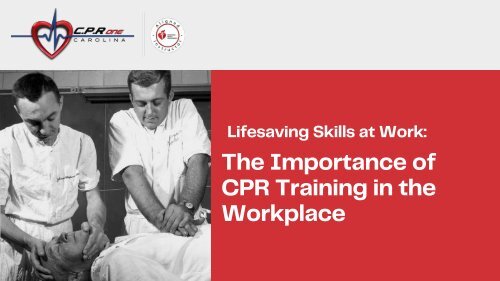The Lifesaving Journey: Tracing the Evolution of CPR Training and Techniques
Cardiopulmonary Resuscitation (CPR) has been a critical lifesaving technique for decades, evolving significantly in its approach and methodology. From its early inception to the modern-day practices, the changes in CPR have been driven by scientific research and a better understanding of human physiology. These advancements have not only improved the effectiveness of CPR but also made it more accessible to the public through widespread CPR classes Charlotte NC.
Cardiopulmonary Resuscitation (CPR) has been a critical lifesaving technique for decades, evolving significantly in its approach and methodology. From its early inception to the modern-day practices, the changes in CPR have been driven by scientific research and a better understanding of human physiology. These advancements have not only improved the effectiveness of CPR but also made it more accessible to the public through widespread CPR classes Charlotte NC.
Create successful ePaper yourself
Turn your PDF publications into a flip-book with our unique Google optimized e-Paper software.
<strong>Lifesaving</strong> Skills at Work:<br />
<strong>The</strong> Importance <strong>of</strong><br />
<strong>CPR</strong> <strong>Training</strong> in <strong>the</strong><br />
Workplace
Cardiopulmonary Resuscitation<br />
(<strong>CPR</strong>) has been a critical lifesaving<br />
technique for decades, evolving<br />
significantly in its approach <strong>and</strong><br />
methodology. From its early<br />
inception to <strong>the</strong> modern-day<br />
practices, <strong>the</strong> changes in <strong>CPR</strong> have<br />
been driven by scientific research<br />
<strong>and</strong> a better underst<strong>and</strong>ing <strong>of</strong><br />
human physiology.
<strong>The</strong> Early Days <strong>of</strong> <strong>CPR</strong><br />
<strong>The</strong> origins <strong>of</strong> <strong>CPR</strong> date back to <strong>the</strong> 18th century, with<br />
techniques like mouth-to-mouth resuscitation being used in<br />
emergency situations. However, it wasn't until <strong>the</strong> mid-20th<br />
century that <strong>CPR</strong> as we know it began to take shape.
Current Trends <strong>and</strong> Best<br />
Practices<br />
Today, <strong>CPR</strong> training is more accessible than ever, with courses<br />
available for people <strong>of</strong> all ages <strong>and</strong> backgrounds. <strong>The</strong> current<br />
guidelines emphasize <strong>the</strong> importance <strong>of</strong> high-quality chest<br />
compressions, with a rate <strong>of</strong> 100-120 compressions per<br />
minute, <strong>and</strong> minimal interruptions.
<strong>CPR</strong> classes Charlotte NC today are a testament to <strong>the</strong><br />
evolution <strong>of</strong> this lifesaving technique. <strong>The</strong>y not only teach<br />
<strong>the</strong> latest methods but also instill confidence in individuals<br />
to act in emergency situations. <strong>The</strong> evolution <strong>of</strong> <strong>CPR</strong> has<br />
been a journey <strong>of</strong> continuous improvement, with each<br />
advancement bringing us closer to <strong>the</strong> goal <strong>of</strong> saving more<br />
lives.
As we look to <strong>the</strong> future, <strong>the</strong> importance <strong>of</strong><br />
<strong>CPR</strong> training remains as significant as ever,<br />
with ongoing research <strong>and</strong> innovation<br />
poised to fur<strong>the</strong>r enhance its effectiveness.

















